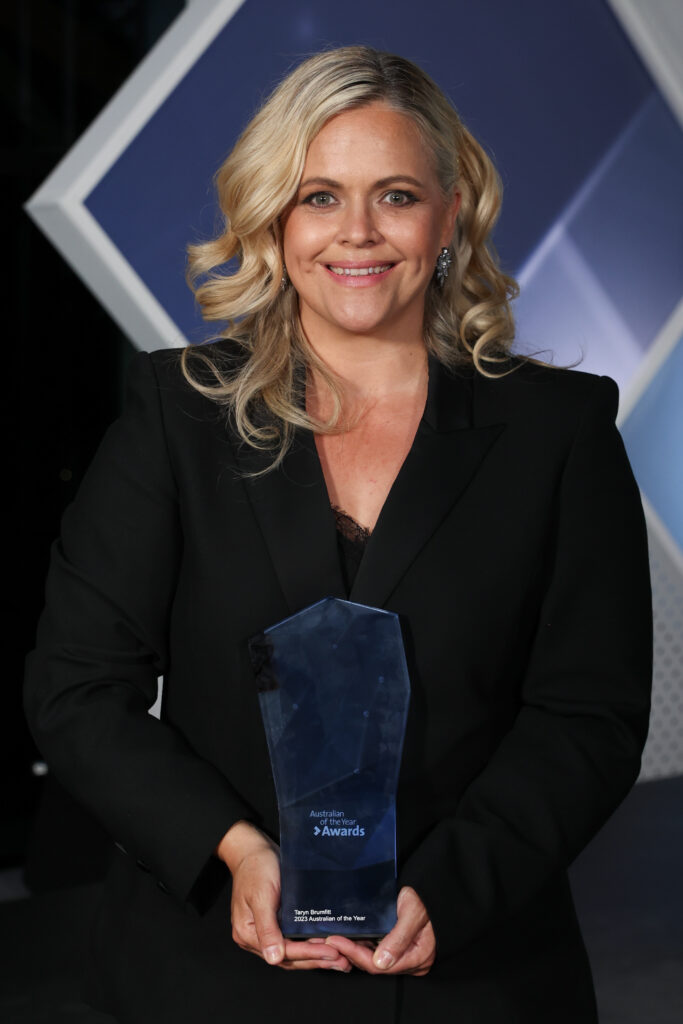WHAT‘S HAPPENING
News & Events
Meet the Adelaide Studios Tenant: Taryn Brumfitt and Body Image Movement
23 November 2023
The SAFC’s Adelaide Studios isn’t just a screen production facility, it’s a creative hub that’s home to 27 South Australian screen businesses and screen practitioners. In this ongoing series of SAFC interview profiles, we invite you to meet the tenants and get to know their work.

The Body Image Movement is a socially conscious movement that aims to redefine how people think about their bodies. As unconventional as it may seem, founder and filmmaker Taryn Brumfitt’s goal to spread body acceptance to every corner of the earth is exactly why she chose Adelaide Studios as the Body Image Movement HQ.
In 2013, Taryn shared a personal “before and after” body picture that went viral. She’s built on that momentum, writing five books (the latest coming in February – Chico the Schnauzer, illustrated by another Adelaide Studios tenant, Levi George of Monkeystack) and directing two celebrated SAFC supported feature documentaries, Embrace and Embrace Kids, working with Anna Vincent and Bonnie McBride of Ringleader Films (also fellow tenants) as producers. She’s made countless keynote addresses and media appearances all over the world, and in 2023 she was made Australian of the Year in recognition of her ongoing advocacy work.
In between Taryn’s recent trip to the USA, where she screened Embrace Kids at Harvard University and attended a dinner hosted by US President Joe Biden at the White House, and the launch of her new early childhood education program “Body Blocks”, we caught up with her to discuss the role filmmaking plays in her advocacy, her experiences as Australian of the Year, and what’s next for her and the Body Image Movement.


You have had a somewhat unconventional journey into the screen industry – tell us about how you got into filmmaking.
I had been a photographer for many years, and always loved telling people’s stories visually – over the years I photographed more than 2,000 people at weddings, family events and other special occasions. But as the Body Image Movement started to take off and I saw the need to get the message of Embrace out to as many people as possible, I realised that making a film would enable me to use visual storytelling in an even more impactful way – and so my first documentary, Embrace, was born!
The Body Image Movement started with your famous before-and-after photo. What made you decide to create a documentary to spread the Body Image Movement’s message?
After the photo went viral, I received more than 7,000 emails and messages from people around the world sharing their own experiences of body image, eating disorders and mental health issues. This issue was so much bigger than I’d realised, and I knew I had to do something. I couldn’t possibly respond to every single message, so I decided to write a book sharing some of the things I’d learnt that had helped me on my own Embrace journey. I then realised I could reach even more people by making a film, and Embrace came out in 2016. It’s now been viewed in more than 190 countries around the world, so I think the film definitely did what we needed it to! It even beat Guardians of the Galaxy and King Arthur at the box office in Germany on opening night!
Embrace Kids came out last year to a fantastic reception. How did the experience of working on that film compare to Embrace?
Given the target audience of this film (9-14 year olds), we had to be really careful about how we approached the subject matter in a considered, age-appropriate way. There were some tough conversations in the office about how we make a film about body image without actually showing bodies, but we found a solution – dogs! Picture 20 of them, all different shapes and sizes, running around on the beach. Our excellent South Australian cinematographer Ben Dowie may have described it as the most challenging days of his life, but it’s such a beautiful sequence in the film to show that it’s our differences that make us special. After all, you’d never ask the sausage dog to round up sheep on the farm, nor would you ask the chihuahua to be the mountain rescue dog! Just like dogs, humans come in all shapes, sizes and abilities, we just need to learn to be more accepting of our bodies like we are of dogs.
Why did you choose to base your business at Adelaide Studios? What do you like about it?
As I’ve often said throughout my filmmaking journey, one person does not make a film – it takes an entire team of brilliant minds and big hearts. And Adelaide Studios is full of brilliant minds and big hearts! There’s nothing like surrounding yourself with other creatives to bring out your best work, and we’ve made some incredible connections during our time here. Even a quick conversation in the kitchen waiting for the kettle to boil can turn into something amazing!
What’s the best thing about being a part of the South Australian screen industry?
The close-knit community here is hard to beat – you don’t find that everywhere. “Collaboration over competition” is a big motto of mine and I think the SA screen industry embodies that. The support of this industry has been vital to our success over the years, and I’m so grateful to the many people and organisations who have backed us along the way.
What’s your favourite thing about your work?
I love hearing people’s stories about all the things they have been able to do since learning to embrace their bodies. I’ll never get sick of it. It might be jumping in the pool with their kids or getting up to sing at karaoke – things they had previously avoided because of how they feel about their body. But when they’re no longer hold back by these feelings? It unlocks this whole new lease on life, and that’s pretty powerful. Not to mention fun!
What’s the biggest challenge you’ve come up against in your work?
Fitting everything in! We have so many plans and ideas for reaching even more people around the world with the Embrace message, and know how urgent it is to do so – body image is one of the biggest issues facing our young people today. We work at an incredibly fast pace but it would be nice if there were a few more hours in the day!
What skills have you picked up from filmmaking that have benefited you in other areas?
Lots! But the main ones would be connecting with people through storytelling, which can play out in so many different arenas, and building high-performing teams where each person is given the opportunity to excel in their field of expertise. A film crew is a great example of how the whole is greater than the sum of its parts, and what can be achieved when you bring all those talented people together.
You were named the 2023 Australian of the Year, which is an incredible testament to your work. How did it feel to receive the honour?
It was such an honour to receive the title, and to be in the company of the many incredible people who have won it before me. Title or no title, we would have kept doing the work we’re doing, but it’s meant that body image has been elevated to a national conversation and is finally getting the attention it deserves. And that means we can start to take meaningful, practical action against the harm and heartbreak that body image distress and eating disorders have caused to so many people.

What has your year been like with the title?
Full on! The year has been exhausting and overwhelming at times, but I’m so committed to our mission to reach one million Australian kids this year that it makes the early starts and late nights worth it.
What’s in the future for the Body Image Movement? What can we expect next?
Our Embrace Kids program will continue into 2024, with lots of exciting initiatives to be rolled out across Australia as part of the Federal Government funding we received earlier in the year. I’ve got a new book coming out in January, Chico the Schnauzer, and we’re in development on an upcoming feature documentary. So we’re not slowing down anytime soon!
Finally, what is your favourite South Australian screen production – TV or film?
Can I say Embrace and Embrace Kids?! Probably not, so I’ll say Speedway and The Last Daughter.
Story by Alex Knopoff
